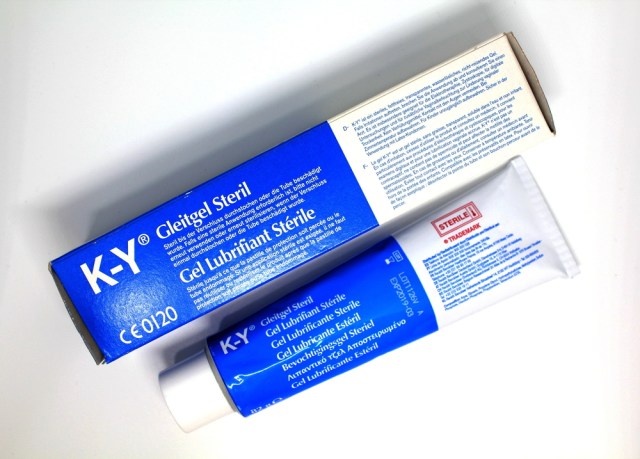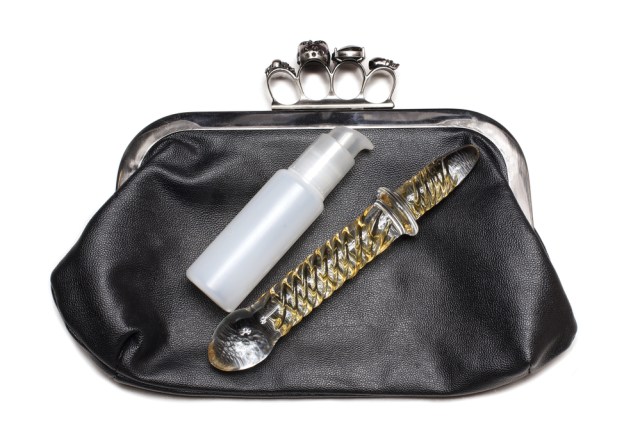
How To Safely Make Yourself Slippery (With Lube!)
Header by Rory Midhani
Feature image by shutterstock
Happy masturbation month! In a previous installment of this column, I’ve explained what happens when you use silicone lube on a silicone toy. But lube makes for such juicy subject matter, and there’s plenty of room left for exploration; I say we go for round two. So crank up some mood music and let’s get into it!

Frankie, aka. “my hero,” surrounded by bottles of “Say Grace” lube. Via Netflix.
What is lube?
“Lube” is short for “sexual lubricant,” and refers to any material used to provide slickness on the genitals during sexual activity. Solo or partnered, lube is a great way to reduce friction and enhance wetness. It can make fisting and anal (among other activities) easier, more pleasurable, and sometimes even safer. Lube makes a good present for any occasion, including routine bike maintenance and sexy games of spin the bottle. If you’re on the go, lube sample packets are easy to tuck in your bra or back pocket. You can also throw them any TSA-compliant liquid baggie and still have room for toothpaste. Versatile! Fun! Totally normal and not gross! Yay lube. You can really never have too much of the stuff.
One of the earliest recorded instances of lube is the use of olive oil to lather up leather dildos in Ancient Greece. (Warning: olive oil is the worst cooking oil for sexual use; do not try this at home.) In 17th century Japan, a slick lube called “tororo-jiru” was made from mashed yams. A few hundred years later, Vaseline entered the scene as a “cure-all” ointment, quickly becoming the first commercially available lubricant as everyone figured out what it could “cure” sexually.
Today, there are a wide variety of commercial liquids, creams, gels and oils available. As in the past (with olive oil, yams, and petroleum jelly), there isn’t anything in particular that ties these materials together from a scientific point of view; it’s more humans being humans, brainstorming about what would make our junk slippery without hurting ourselves.
![a [suggestive] ear of corn and a bottle of vegetable oil](https://develop.autostraddle.com/wp-content/uploads/2017/05/shutterstock_393654439.jpg?resize=640%2C427)
Probably don’t try this one either. Via Shutterstock.
Rules and Regulation
While there’s little government regulation around sex toy safety in the United States, the FDA does regulate lubricant. Since 1976, it has been classifying personal lubricants as medical devices… depending on how the product marketed itself. Explains Scott Geibel in the Journal of the International AIDS Society,
Under the 1976 FDA regulation 21 CFR 880.6375, a lubricant is considered a “medical device” when “intended for medical purposes that is used to lubricate a body orifice to facilitate entry of a diagnostic or therapeutic device.” Personal lubricant products that claim to “moisturize” or “cleanse” have often been considered as a “cosmetic.” In 2003, the FDA announced a safety and efficacy review, and clarified how moisturizer/lubricant product claims to decrease pain, enhance sexual pleasure or contain spermicide would be categorized. Such product statements would be considered to be “drug” claims since they are related to easing discomfort or alleviating a condition (“mitigation or treatment of disease”). Furthermore, the FDA announcement stated they would not consider lubricants/moisturizers to be “cosmetic claims because they do not relate to ‘cleansing, beautifying, promoting attractiveness, or altering the appearance.””
Around 2013, following a handful studies showing worrisome range in the safety of lube on the market at th time, the FDA began to consistently enforce the categorization of lubricants as medical devices, notifying noncompliant companies and seizing shipments. Today, the General Hospital and Personal Use Device section of the General Medical Devices Panel within the FDA’s Center for Medical Device & Radiological Health considers “patient lubricants” to be Class II (higher risk/special controls) medical devices when promoted as being compatible for use with condoms. This means that prior to putting their product on the market, lubricant manufacturers must register and list their product with the FDA; label it according to FDA requirements; report adverse events in the same way other medical device companies do; and follow basic manufacturing quality assurance requirements set by the FDA. Effectiveness testing is not directly required, but manufacturers do have to check biocompatability, following international test standards to show that the product will be safe for mucosal membrane contact.
One item notably missing: human clinical trials. These are not required by the FDA in cases where the manufacturer can demonstrate that their product is “substantially equivalent” in safety and effectiveness to a product already on the market. For most lubes, there is a “predicate” product already being sold with similar ingredients, so manufacturers simply disclose the chemical makeup and test safety of the final product with female rabbits or guinea pigs instead. PETA has raised objections to this and proposed alternative test methods, but not all companies have the resources or interest to pursue non-animal testing (which is usually more expensive). The FDA has stated that it will accept in vitro testing for toxicity assessments, but there currently exists no approved in vitro test for vaginal irritation and sensitization.

Via Shutterstock.
From my perspective (as someone who used to work as lead compliance manager for a company making children’s products), FDA regulation of personal lubricants is excellent news for consumers on the whole. While not foolproof, applying medical device standards helps to keep to dangerous products off the market. It also means that anyone with questions about a particular product can look it up the company’s submissions in the FDA database. For example, here’s the February 2017 Health & Human Services letter concerning Astroglide® Diamond Silicone Gel Personal Lubricant. Among other things, we can see that it has a shelf life of at least two years, and has passed compatibility testing for condoms made of natural rubber latex, polyurethane, and polyisoprene. In comparison, Love Liquid Personal Lubricant is not compatible with polyurethane condoms, and only demonstrated a shelf life stability of 9 months at the time it wrote the FDA in February 2016. (Both products passed biocompatibility testing, though.)
One downside to FDA regulation is that it does create an additional barrier for smaller companies to enter the market, as manufacturers bear the cost of all required third party testing. In a 2015 interview with Vice, Simply Slick CEO John Goepfert estimated the approval process took about two years and over $200,000. On the other hand, as he shared with Hopes and Fears, “It doesn’t matter if it’s [financially] manageable. If I make an unhealthy product, if you get genital warts or breast cancer, is the fact that I didn’t want to spend $40K ok with you? If you don’t understand from a chemistry standpoint how your product interacts with human beings, if you do damage in that process, is that ok with you? So if you’re in the business to make a lubricant, $40K is the cost of business.”

Via Shutterstock.
Frisky, Risky Business
Outside the realm of regulation, there are some things individuals can watch out for when it comes to lube safety. Namely:
- Nonoxynol-9 (spermicide). Stay far away from this stuff, particularly if you’re having sex with a partner who may be HIV positive. Nonoxynol-9 not only is ineffective in stopping HIV spread, it’s actually shown to increase the risk of HIV infection among women who use nonoxynol-9 containing products frequently, according to the World Health Organization.
- Benzocaine and other numbing ingredients should also be avoided. Decreasing your body’s ability to sense pain means you’re willingly decreasing your body’s ability to warn you if an activity is hurting you! Obvious recipe for disaster/injury. Plus, benzocaine is an irritant.
- Compatibility with different condom materials, if using. Check the packaging of your lube, and if it doesn’t list any restrictions, take a minute to read the company’s website and search FDA.gov to see what information is publicly available in their filings. Keep in mind that older products may have been tested under more relaxed standards, and that oil-based lubes are incompatible with latex.
- Osmolality of water based lubes (ie. how prone the product is to promoting osmosis, or water diffusion). This is a bit of a tricky one because there’s so little information out there, but osmolality is good thing to pay attention to if you’re trying to conceive or have a compromised immune system. Smitten Kitten has done some really excellent in-depth research on the subject, which you can read a writeup on Dangerous Lilly about here or purchase the original pamphlet from Smitten Kitten here. While you’re there, check out their information on pH and specific product recommendations.
- Allergens, irritants and things that feel yucky to you. This is specific to you and your body, but many people have difficulties with warming and cooling lubes. Microbicides such as chlorhexidine gluconate or sodium hydroxide can cause genital dryness, and vulva-owners prone to irritation and/or yeast infections are often better off avoiding glucose and glycerin (present in most drugstore lubes). Propylene glycol and parabens are two other commonly reported irritants. If these ingredients don’t cause a problem for you personally, great! Feel free to use products that include them. If you run into problems, though, keep track and make sure you’re only using products that work with your body.
- Misinformation. There is so much bad sex information out there! For example, a couple weeks ago Gwyneth Paltrow published a piece on GOOP with the advice that “if it’s safe to eat it’s generally safe to apply [as sexual lubricant]” This is absolutely not true! Ingesting something orally is very different from applying it to one’s genitals. When you hear new information that seems questionable, look it up. Read widely, think critically, and if something sounds questionable, look for another source.
Now go forth and lube!
Notes From A Queer Engineer is a recurring column with an expected periodicity of 14 days. The subject matter may not be explicitly queer, but the industrial engineer writing it sure is. This is a peek at the notes she’s been doodling in the margins.
